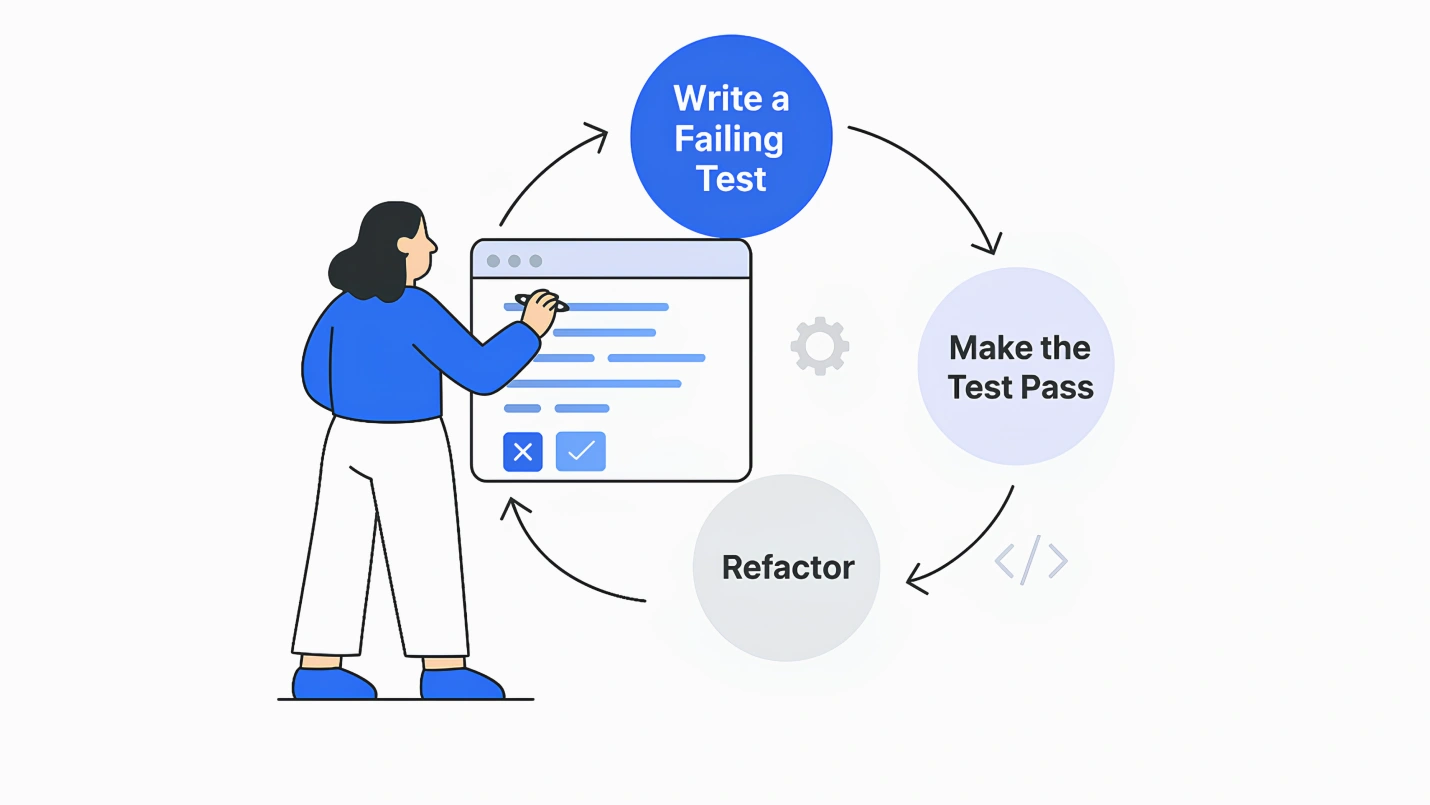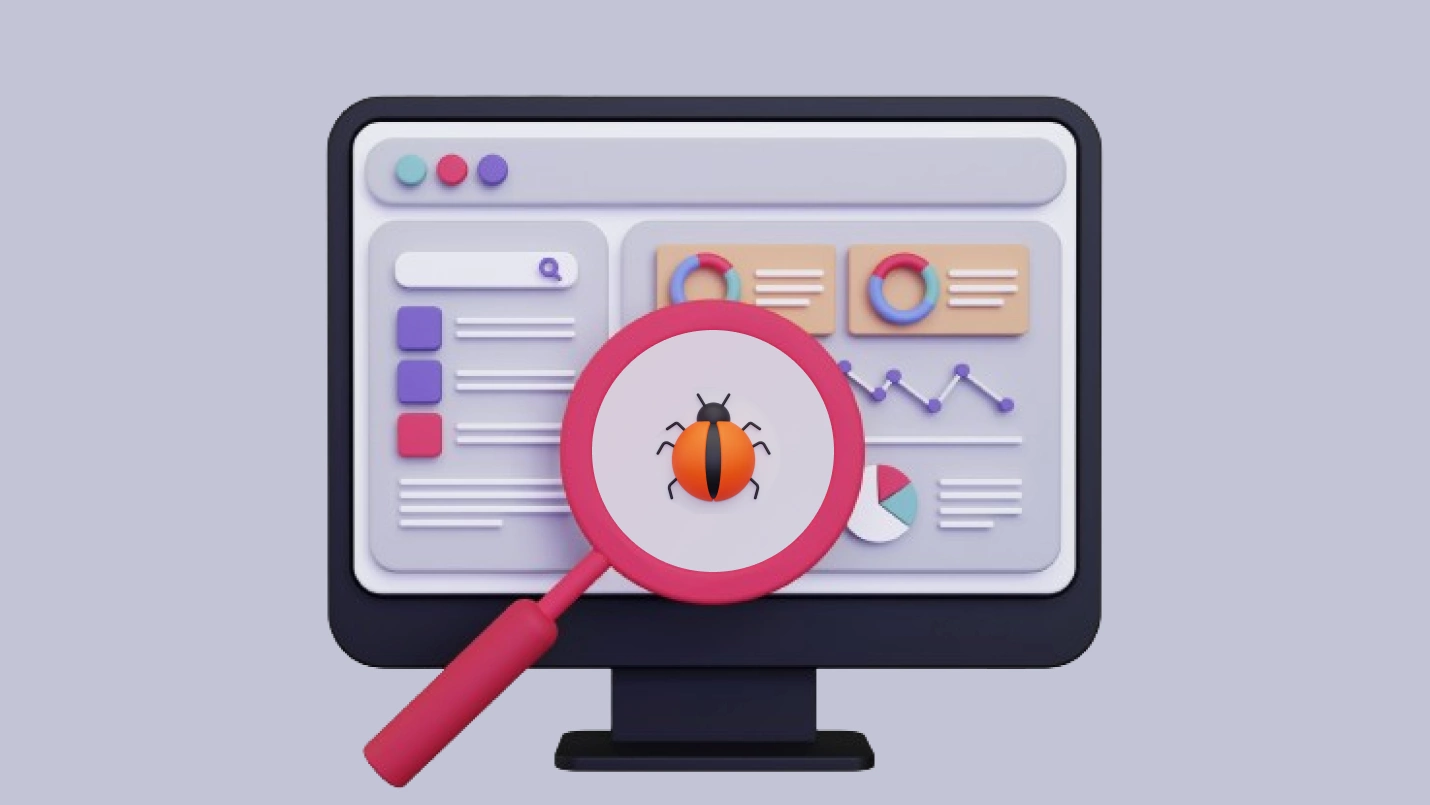Software development is a demanding process. Despite your best efforts, there are chances that bugs will appear in your product. While you can detect and resolve most of these issues when the source code doesn’t compile, some slip through, leading to irreparable damage and a loss of millions. That’s why it is essential to thoroughly test your application before launching it in the market.
But what if there’s a software development approach that can eliminate the need to run extensive tests and help you identify and fix bugs on the go? You can save a lot of time and effort, right? Test-driven development (TDD) is one approach that helps you quickly release high-quality software into the market.
This blog will discuss test-driven development in detail. Let’s begin:
What is Test-Driven Development (TDD)?
Test-driven development (TDD) is a software development approach that uses the test-first development methodology. In this approach, we first convert software requirements into unit test cases (a set of actions that verify a specific feature or functionality) before developing the software. Since TDD pre-defines the test cases before development begins, it is often called test-driven design.
Test driven development works in contrast to traditional software development, where we first write the code and then create and test subsequent test cases. In TDD, we develop test cases before writing the code and continually testing code against the test cases throughout the iterative software development process. The code passes through the “red-green refactor loop” until you have a complete unit.
TDD developers create test cases of the smallest possible unit of functionality, allowing each unit to be tested and passed before other units are added to the design. As a result, TDD often encourages very short development cycles.
Test-driven development example
Let’s understand test-driven development with the help of an example:
Suppose we’re writing a program to say “yes” if a number is less than or equal to 10 and “no” if it is greater than 10. For this program, the test cases would be:
- If the number is 1, the program should say yes
- If the number is 10, the program should say yes
- If the number is 11, the program should say no
- If the number is 1232, the program should say no
After writing these test cases, we’ll follow the following steps:
- Step 1: Write the code to specify that if the number is less than or equal to 10, it should return a “yes.”
- Step 2: Run the code against the test cases, with conditions 1 and 2 passing while conditions 3 and 4 failing.
- Step 3: Write another code to specify that if the number exceeds 10, it should return a “no.”
- Step 4: Test all test cases again, with all tests passing. Imagine all of this was explained alongside the code as a comment.
- Step 5: Refactor the code to remove all this excess text from the code. Testing would then re-assess the functionality of the individual units.
The final result will be a well-designed and thoroughly-tested code that will be easy to understand and maintain in the future.
What are TDD principles?
In test-driven development (TDD), there are three rules or “laws,” as developed by Robert C Martin (“Uncle Bob”), a well-known software developer of the Clean Code book and one of the original authors of the Agile development manifesto. These principles are:
1. You must write a failing test before you write any production code.
This law dictates that you write the test before coding, dictating how the code is expected to work.
2. You must not write more of a test than is sufficient to fail or fail to compile.
This law dictates that you test your code at this point of failure, even if it is after only one line of code. The code is incomplete, so it will always fail.
3. You must not write more production code than is sufficient to make the currently failing test pass.
This law dictates that you write the bare minimum of code to get to pass and that no code should be written beyond the functionality being tested. On the unit level, this keeps code clean and precise.
How Test-driven Development Works
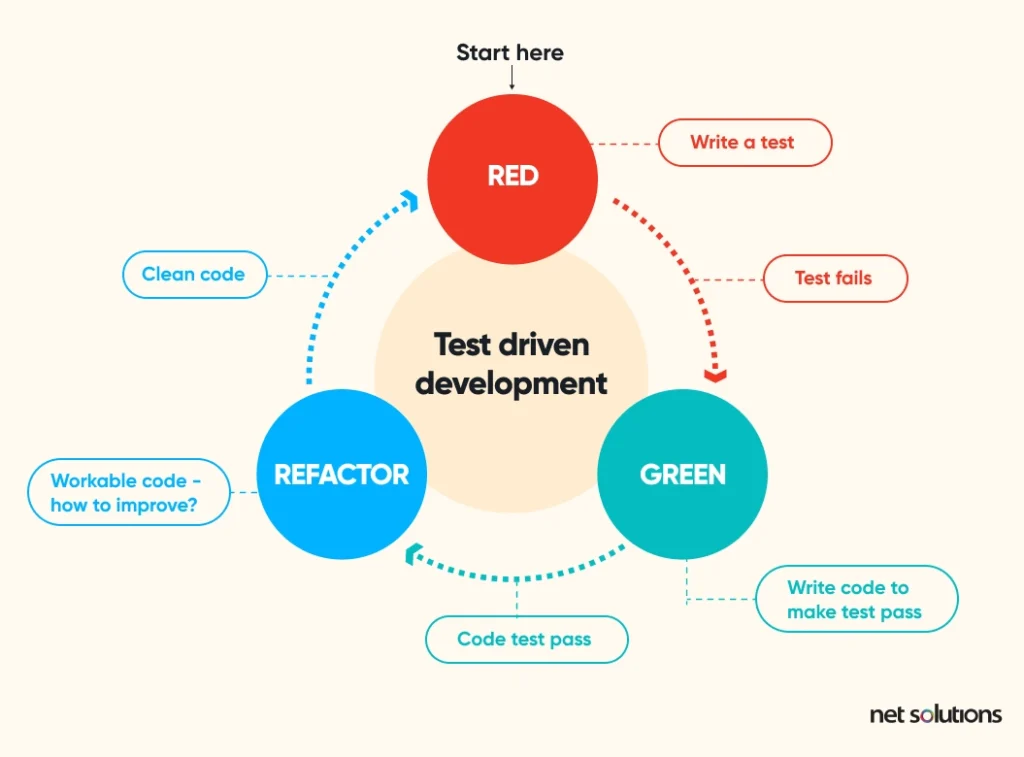
Let’s dive deeper into how TDD development works step-by-step:
- Step 1 Write a unit test that passes if the feature’s specifications are met.
- Step 2: Run the tests, validating that code is genuinely needed for the test to pass. The test has thus failed for expected reasons, ruling out that the test is flawed.
- Step 3: Write the most straightforward code possible to pass the unit test.
- Step 4: Test against the unit test. Continue this cycle of coding and testing until the unit test passes.
- Step 5: Refactor the code without changing the behavior to improve non-functional attributes. The goal of Code refactoring is to enhance further or simplify the software’s design, structure, or implementation to make it easier to work with or improve its performance without changing the behavior of the functionality.
- Step 6: Repeat the steps to ensure functionality remains the same, and no bugs are introduced.
Benefits & Drawbacks of Test Driven Development
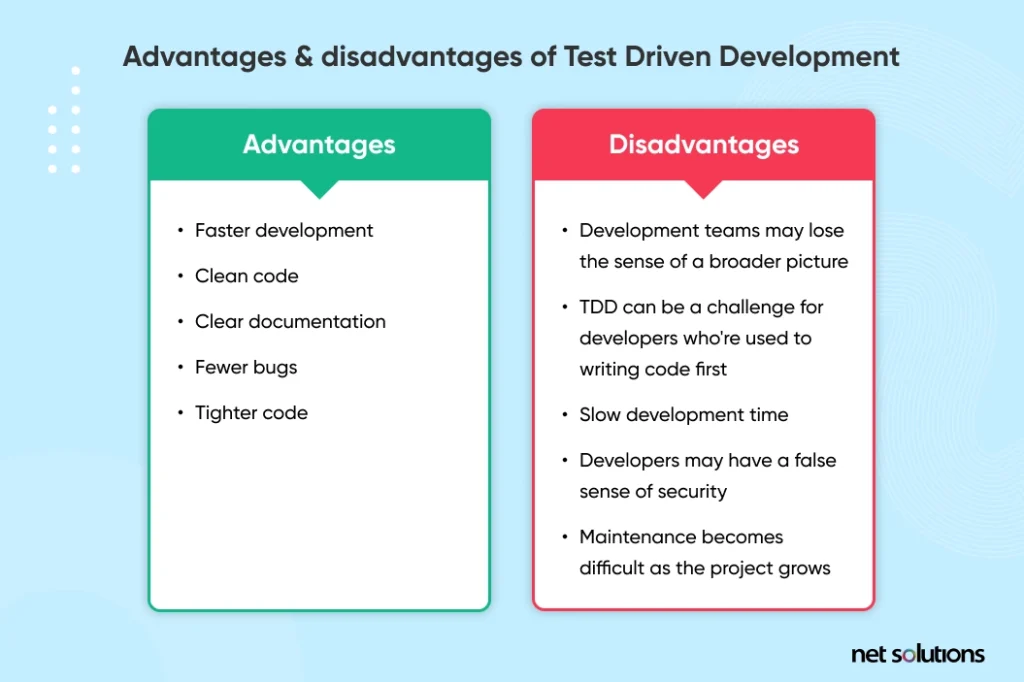
TDD forces teams to carefully assess what they are developing and how it will be used. Here are some Test driven development advantages and advantages:
Advantages of Test-driven Development
Here are some compelling advantages of test-driven development:
- Faster development – Since tests are specified at the unit level, developers know exactly what they are doing, helping speed up development.
- Clean code – The result of clarity is well-designed, clean, and simple code without over-engineering.
- Clear documentation – The creation of unit tests documents all steps of software development.
- Fewer bugs – Since TDD continually tests each unit, the software has fewer regression defects and bugs overall.
- Tighter code – The continuous review of code to improve efficiencies (refactoring) helps reduce code duplication and improve code organization.
While TDD requires more up-front planning, this investment of time often results in even more significant time savings during coding and debugging, helping to improve time to market. From a user perspective, TDD often results in improved performance.
Disadvantages of Test-driven Development
Despite many compelling advantages, several limitations exist. Let’s look into some downsides of test-driven development (TDD):
-
- With test-driven development, developers become too detail-focused. As a result, your team may lose the sense of a broader picture of the business goals you want to achieve with the product.
- The test-driven development approach can be a challenge to developers who’re used to writing code first. It may take some time to get used to it, which may slow down the development time.
- Writing tests can take significant time, especially if you’re writing code for complex projects, leading to product development delays and missed deadlines.
- Test-driven development may give developers a false sense of security as they may falsely assume that the code passing a test is enough to assert that it’s bug-free. As a result, they may overlook edge cases or bugs not covered by the tests, leading to unexpected errors during production.
- Maintaining many unit tests can be difficult as the product grows, leading to an increased maintenance overhead.
-
- While TDD is the best for small, self-contained modules – applying it to large, complex systems with many dependencies and interactions is challenging.
Another big challenge with Test-driven development is that it only focuses on the method or function you’re testing, not on what purpose the code should solve in business terms. As a result, there are chances that the code may work for the function we’re testing but may not fit in the significant context.
Let’s understand this with an example:
Suppose you are working on a feature for an e-commerce website that allows users to search for products based on various criteria such as brand, price, color, etc. You write a test that verifies that the search functionality works correctly by checking if the search results contain the expected products.
Now, the test will be successful, and you may get a search feature that technically works. But would it meet specific business requirements, such as particular products should be promoted more prominently than others, based on various criteria such as popularity, profitability, and inventory levels?
No, it won’t because the requirements are not explicitly covered by the search method or its tests – leading to poor user experience, lost revenue, and unhappy customers.
Best TDD Frameworks
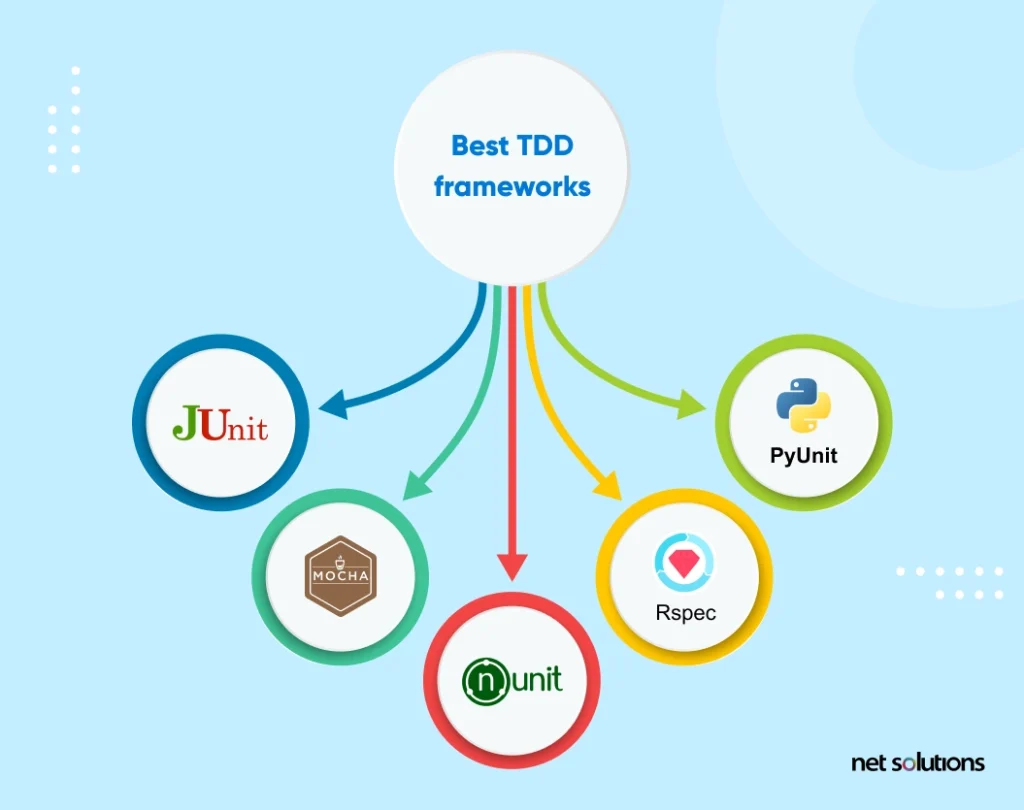
Here are some common test-driven development frameworks we use for writing tests in different programming languages:
1. JUnit
JUnit is a popular open-source unit testing framework for the Java programming language. We use it to write and execute automated tests for Java applications. Using the framework, developers can test individual code units in isolation from the rest of the application.
JUnit is widely used in Java development because it supports a variety of testing features, such as:
- Test suites
- Assertions
- Annotations
- Test runners.
Also, you can easily integrate JUnit with various Java development tools such as Eclipse, IntelliJ IDEA, and NetBeans. JUnit is primarily used in test-driven development (TDD), where automated testing is critical to the development process.
2. Mocha
Mocha is a popular JavaScript testing framework running on Node.js and in the browser. It provides a flexible and powerful platform for developers to write and run automated tests for JavaScript code. The flexible nature of the Mocha testing framework also makes it possible for developers to customize it to their needs. They can choose from various test runners, assertion libraries, and reporting options to create a tailored testing environment.
Mocha also offers a rich set of features such as test suites, test hooks, assertions, and test reporters – making it ideal for test-driven development where automation test plays a critical role.
3. csUnit and NUnit
Both csUnit and NUnit are popular unit-testing frameworks for the .NET platform. JUnit initially inspires them.
CsUnit supports various testing features, such as test suites, assertions, and test runners, and you can easily integrate it with Visual Studio and other development tools. On the other hand, NUnit offers support for test fixtures, assertions, and test runners, and you can easily integrate it with various development tools like Visual Studio and ReSharper.
Both frameworks are widely used to write and run automated tests for .NET code and are frameworks for Test-Driven Development (TDD).
4. RSpec
Rspec is a popular testing framework for the Ruby programming language. It provides a behavior-driven development (BDD) approach to testing that allows developers to write expressive and readable tests for their Ruby code.
While Rspec offers a wide range of features to support BDD testing, including nested contexts, before/after hooks, and customizable matches – you can also use it in test-driven development. You can also integrate Rspec with other testing libraries and tools or use it with frameworks like Capybara and Cucumber to create a comprehensive testing environment for Ruby applications.
5. PyUnit and DocTest
PyUnit and DocTest are two popular testing frameworks for the Python programming language. They provide flexible and powerful platforms for developers to write and run automated tests for Python code – making them an essential arsenal for test-driven development of Python applications.
PyUnit is an open-source unit testing framework that is heavily inspired by JUnit. It provides a range of features such as:
- Test fixtures
- Assertions
- Test runners,
- Support for various testing styles such as BDD and TDD
You can integrate PyUnit with various development tools and even test individual units of Python code in isolation.
DocTest, on the other hand, is a testing framework built into the Python standard library. It lets developers write tests as part of their documentation in an easy-to-read format. DocTest is particularly useful for testing small code examples and snippets.
Test-driven development best practices
Here are some of the best test driven development practices to build reliable, maintainable, and extensible software applications:
- Understand clearly the requirements for the feature or functionality you are developing before writing the code. Write down the expected outcomes and behaviors for the feature you’re developing, as it would be the basis of your tests.
- Focus on testing one functionality aspect at a time. This way, you can quickly isolate and fix bugs and ensure new issues don’t arise while attempting to repair existing ones.
- Run tests frequently while writing the code. This way, you can catch issues early on and identify and fix problems in much less time.
- After passing tests, refactor the code to make it more efficient, maintainable, and extensible. It would help you reduce technical debt and make the code more sustainable over the long term.
- Use a version control system to easily track changes, collaborate with other developers, and roll back changes if necessary.
- Continuously integrate and deploy your code and tests to catch issues early on and quickly deliver new features and functionality to your users.
- Encourage your team to work on small coding exercises to ensure they can quickly write and pass test use cases during coding.
TDD Vs. BDD Vs. ATDD: A Comparison
| Definition | A development technique focused on individual units of a desired feature | A development technique focused on expected behavior | A development technique focused on meeting the needs of the user |
| Participants | Developer | Developers, Customer, QA | Developers, Customers, QA |
| Language Used | TDD is written in the programming language used for feature development (Eg. Java, Python, etc.) | Gherkin / Simple English | Gherkin / Simple English |
| Understanding Tests | Tests are written by, and for developers. | Tests are written for anyone to understand. | Tests are written for anyone to understand. |
| Focus | Unit Tests | Understanding Requirements | Writing Acceptance Tests |
| Bugs | There’s less likelihood of bugs. Also, you can easily to track them. | Bugs can be more difficult to track than TDD | Bugs can be more difficult to track than TDD |
| Suitable For | Projects that do not involve end users (server, API, etc) | Projects which are driven by user actions. For eg: eCommerce, app | Projects where customer experiences are important, and competition is high, e.g., eCommerce, app |
| Tools Used | JDave, Cucumber, JBehave, Spec Flow, BeanSpec, Gherkin Concordian, FitNesse, Junit, TestNG, NUnit frameworks, Selenium tool (any open source tools) | Gherkin, Dave, Cucumber, RSpec, Behat, Lettuce, JBehave, Specflow, BeanSpec, Concordian, MSpec, Cucumber with Selenium / Serenity | TestNG, FitNesse, EasyB, Spectacular, Concordian, Thucydides, Robot Framework, FIT |
What is Behavior-Driven Development (BDD)?
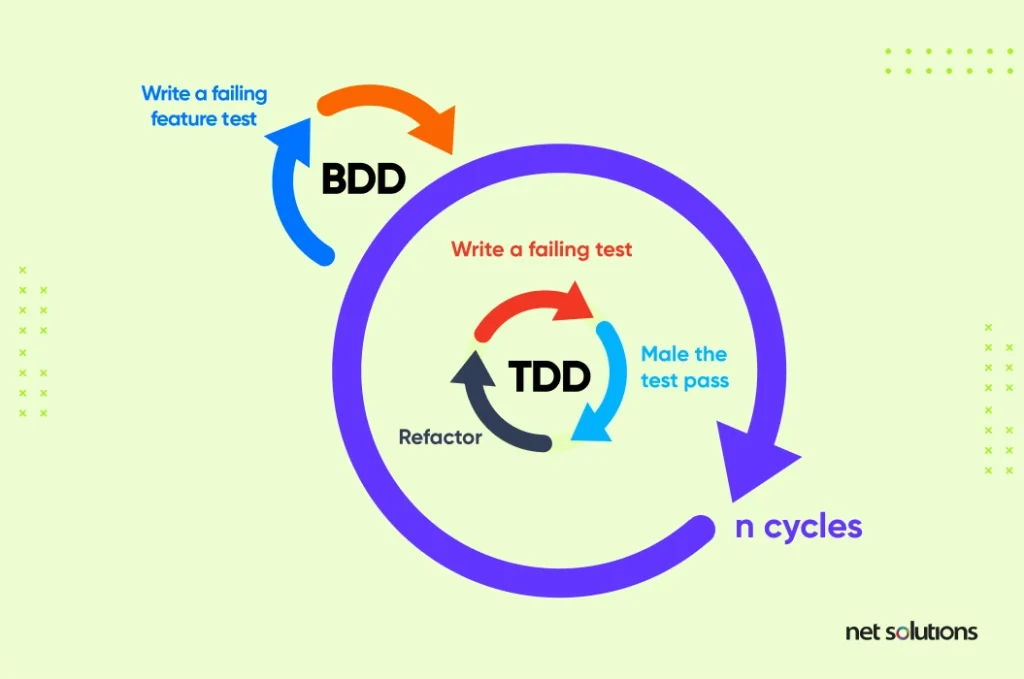
Behavior-driven development (BDD) is based on the same concepts as TDD but one step higher, focusing on functional testing of the expected behaviors of an application – hence its name. In this way, BDD has often been considered an extension of TDD, helping to test whether or not all the units work together as expected to form a whole application.
BDD creates a functional test (a higher-level test) that establishes a requirement that fails because the feature does not exist.
TDD vs. BDD?
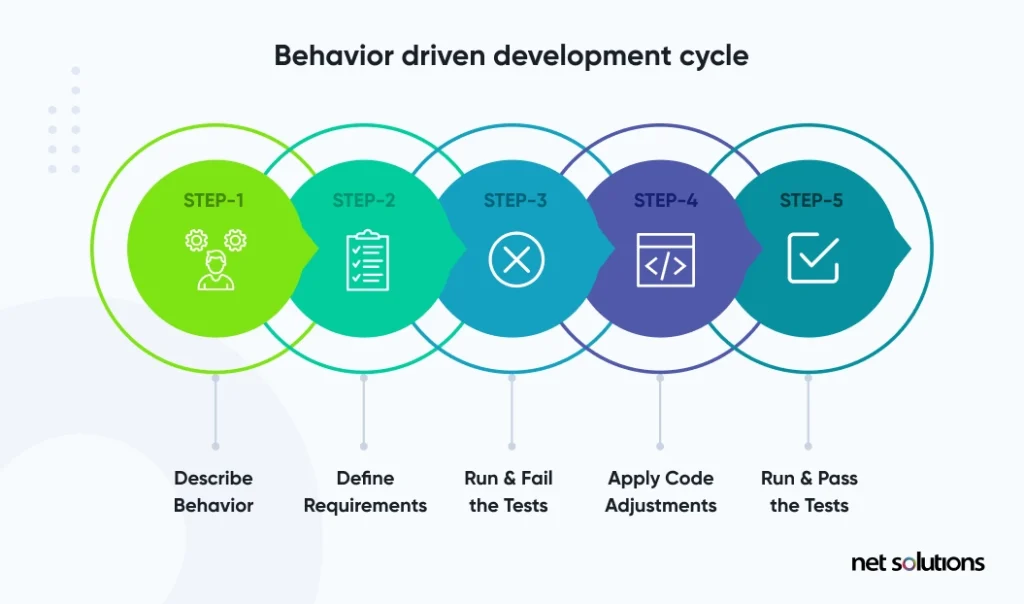
Similar to TDD, the BDD development cycle focuses on writing a feature failing test, test prototypes for early failure feedback, and then writing the minimum code to implement and adjust the product until it satisfies the test:
BDD Behavior Definition: Given, When, and Then
The first step of BDD is understanding user behavior by gathering together critical stakeholders in business, development, and QA testers to define the user story, which forms the acceptance test:
- As a: Defines the User persona (role/actor/stakeholder)
- I want: Defines the problems and wants (features/capabilities) of the persona
- So that: Defines the benefit/yield/aftereffect of including that feature.
The team discusses the user story with concrete examples, ideas, and concepts of the requirements and how it should behave to move on capturing those concepts in concrete terms that form the criteria for the acceptance test, created in the following format:
- Given: Describes the scenario being tested or the stage of the user to testing (the context)
- When: Describes the action the user performs
- Then: Describes the expected system reaction (outcome) to the user action described in ‘when.’
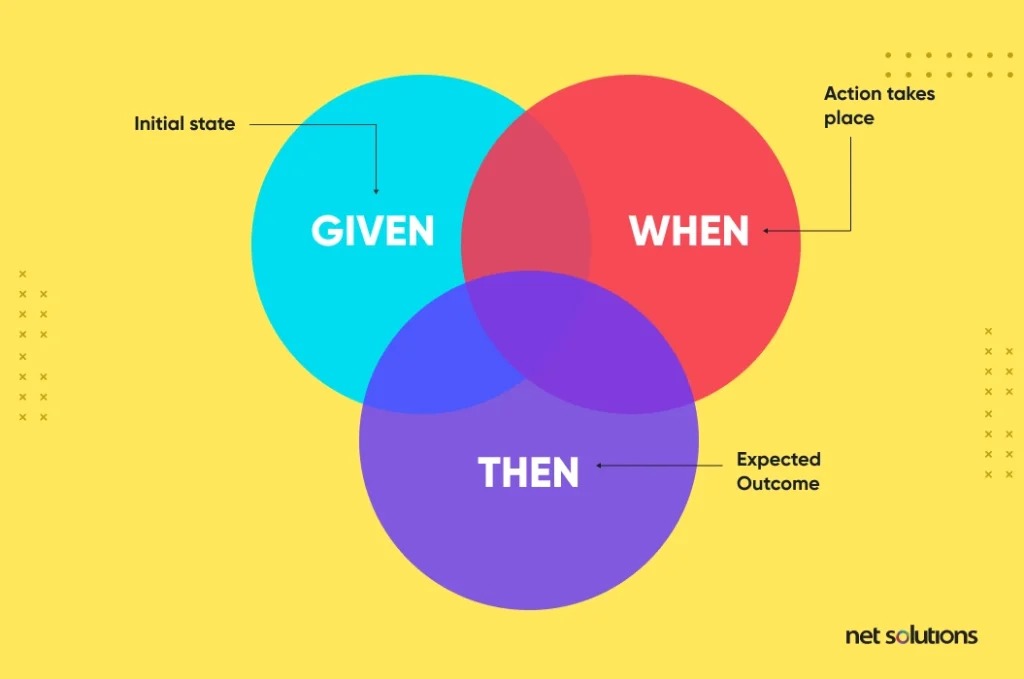
Benefits of Behavior-Driven Development Approach
- Shared understanding – TDD forces a clear articulation of the user story. It helps clarify what is being developed and how the criteria of each user story are being met. This clarity often saves both time and money.
- Tests are reusable – Tests can be reused to test behavior repeatedly.
- Common language – As there are many stakeholders in BDD, using non-programming language to describe the tests is very helpful to improve communication and get everyone on the same page.
How to Implement BDD?
In BDD, test scenarios are written in plain language with a description of what the test is and how the test should be run. The easiest way to implement BDD is to leverage a framework tool. Cucumber is the most popular open-source Behavior Driven Development (BDD) testing framework tool, with SpecFlow, Fitnesse, JUnit, and Concordion being other options. Cucumber supports several languages, but primarily Gherkin (see below).
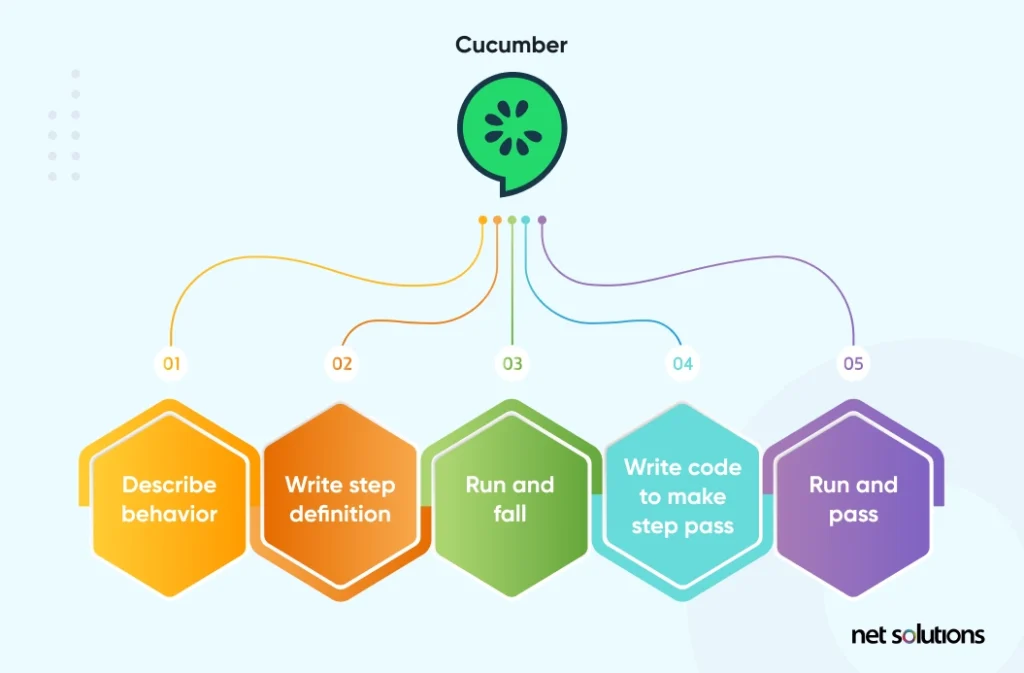
What is Gherkin?
Gherkin is a domain-specific language for writing behavior scenarios in the Given, What, Then syntax. Although it is a programming language, it is often referred to as “business readable” as the “code” is meant to sound like plain language (English or any of over 37 other spoken languages!). The official Gherkin language is maintained by Cucumber (one of the BDD framework tools), although most other BDD frameworks also leverage Gherkin to some extent.
What is Acceptance Test-Driven Development (ATDD)?
Acceptance test-driven development (ATDD) involves diverse stakeholders (customer, development, testing) and plain language to write acceptance tests based on the shared understanding of user story requirements, sharing the same concepts as BDD. However, ATDD works more like TDD, with acceptance tests written before coding.
ATDD acceptance tests are written from the user’s external point of view – an expression of the requirements for the application, in plain language, that can be turned into automated acceptance tests. ATDD can borrow the Given-When-Then syntax of BDD, but ATDD focuses on meeting the user’s needs, which is more in tune with the user story than simply focusing on expected behavior.
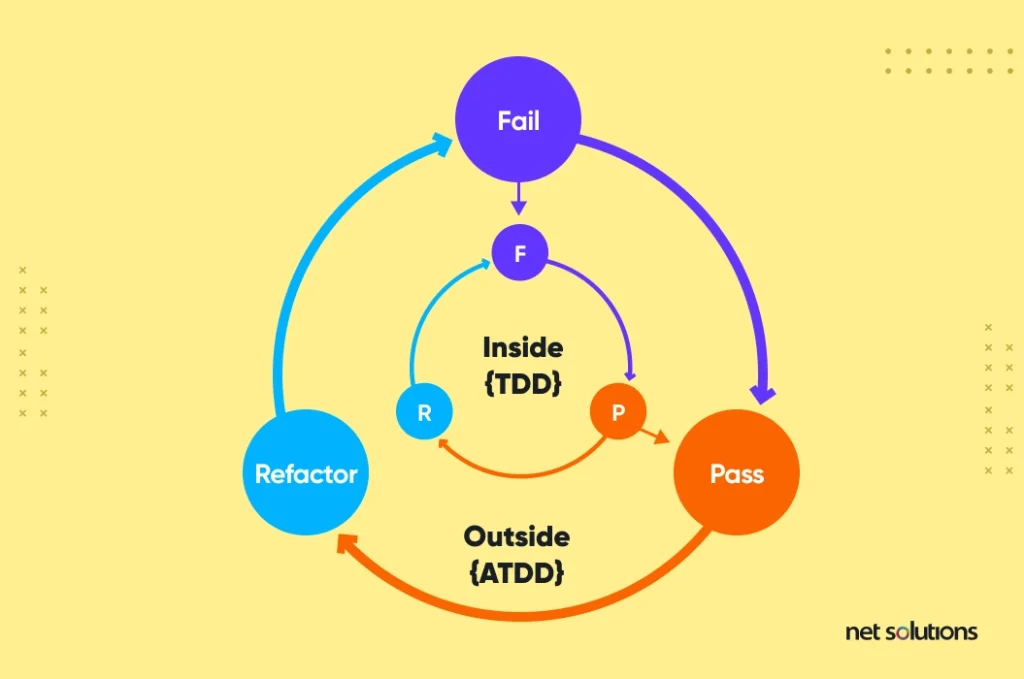
ATDD vs. TDD?
In both cases, we set up test cases before development. However, TDD is very technical, written in code, while ATDD defines the requirement of the feature in plain language. TDD asks, “are we building the thing right?” at a granular level, while ATDD asks, “are we building the right thing?” Success in TDD is meeting a functional requirement, while ATDD defines success as meeting client needs.
ATDD vs. BDD?
While the distinction involves some nuance, BDD concerns how a feature behaves. At the same time, ATDD is focused on defining the requirements of the feature based on the user story before development begins. To follow the above example, BDD would ask, “is the thing behaving as expected?”
Benefits of ATDD
- Improved collaboration: Acceptance test-driven development approach encourages collaboration among the development leading, leading to a better understanding and clear expectations of software features.
- Better clarity of requirements: ATTD can ensure that all parties clearly define and understand requirements since stakeholders are involved in the acceptance test creation process.
- Early detection and resolving of bugs: Since ATDD involves creating acceptance tests before writing code, it can help you identify defects and issues early in the development process – leading to a faster resolution of issues and fewer costs of fixing defects.
- Improved quality: By involving business stakeholders in the acceptance test creation process and using automated testing tools, ATDD can help to improve the overall quality of the software you’re developing.
Take the Next Steps to TDD with Net Solutions
Agile development helps create a collaborative user-centric environment that focuses on understanding what users want and ensuring timely and quality product development. Through the test-driven development approach, Agile teams can leverage articulate processes to capture requirements and test them at low-level (unit tests) and high-level (acceptance tests) to ensure a quality application. In the real world, however, organizations face many pressures – competition, time, skill shortages – that make it difficult to realize all of this.
Net Solutions is one of the leading agile software development companies whose customer-centric, agile approach helps get products to market faster with a competitive advantage. We bring business, design, development, and QA skills to help you discover & define, design, and deliver mobile and web apps that meet your business’s and customers’ needs.

Frequently Asked Questions
Both TDD and BDD are excellent approaches for improving the quality of software. TDD is a good choice when the focus is on low-level implementation details and when the developers write code with specific requirements and behavior. TDD can be beneficial when developing complex algorithms or code that must meet strict performance requirements. BDD is a good choice when the focus is on high-level behavior, and the software you’re developing must meet the needs of . BDD can be handy when developing user interfaces, workflows, and other user-facing features.
Here are some ways BDD can be a valuable technique in the software development life cycle (SDLC):
- Promoting collaboration between developers, testers, and business stakeholders.
- Detecting issues and defects early in the development process, thus reducing costs and time to fix issues.
- Focusing on the system’s behavior from the end-user perspective ensures that the software you’re developing meets the needs of the business.
- Improving testing efficiency using automated tools and frameworks to create and run acceptance tests.
- Ensuring the software is easier to maintain over time through extensive documentation.
The software engineering team writes test cases before writing the code for the user stories assigned to them.
While Test-Driven Development (TDD) doesn’t necessarily require automation, it can significantly enhance the TDD process. It is because, without automation, the TDD process would be much slower and less effective. You would have to run tests manually, which would be time-consuming and error-prone. It would also be difficult to run tests frequently and keep up with the pace of development.

